The History Of Mazda FORD Laser Sedan

The Ford Laser is a compact car sold by Ford in Asia, Oceania, and parts of South America, and Africa. It has generally been available as a sedan or hatchback, although convertible, wagon and pick-up versions have also been available in different markets.
The Ford Laser was a restyled version of the Familia/ 323 models produced by Mazda in Japan from 1980 onwards. (Ford had acquired a 25% stake in Mazda in 1979.)
In Australia and New Zealand where Ford was seen as a 'local' brand, the Laser outsold its Mazda twin, but in neighbouring Asian countries, such as Singapore, Malaysia and Hong Kong, as well as Japan itself, the reverse was the case. However, pooling resources with Mazda allowed Ford to maintain a foothold in the region. This was also the case in South America, Africa, and the Caribbean, where the Laser was also sold, in many cases being locally assembled.
KA/ KB
KA 1981-1983, KB 1983-1985
Engine specifications:
- Mazda E1, 41kW 1.1L Carb 8V SOHC (‘L’ and ‘GL’ New Zealand models)
- Mazda E3, 49kW 1.3L Carb 8V SOHC (‘L’ and ‘GL’ models)
- Mazda E5, 54kW 1.5L Carb 8V SOHC (‘L’, ‘GL’ and ‘GHIA’ models)
- Mazda E5, 59kW 1.5L Twin Carb 8V SOHC (‘Sports’ models)
- Mazda E5T, 78kW 1.5L Carb 8V SOHC Turbo (limited edition‘Turbo’ models)
- Mazda E5T, 85kW 1.5L EFI 8V SOHC Turbo (‘Turbo’ Japan models)
KC/ KE
Engine specifications:
- Mazda E3, 49kW 1.3L Carb 8V SOHC (‘L’ and ‘GL’ models)
- Mazda E5T, 85kW 1.5L EFI 8V SOHC Turbo (‘Cabriolet’ Japan models)
- Mazda B6, 53kW 1.6L Carb 8V SOHC (‘GL’ and ‘GHIA’ models)
- Mazda B6, 61kW 1.6L EFI 8V SOHC (option on ‘GHIA’ models and standard on ‘TX3’ models)
- Mazda B6T, 100kW 1.6L EFI 16V DOHC Turbo (‘TX3 Turbo’ and ‘Turbo 4WD’ models)
KF/ KH
1990-1994
Engine specifications:
- Mazda B6-2E, 64kW 1.6L Carb 16V SOHC (‘XL’, ‘GL’, ‘Horizon’ and ‘Indy’ models)
- Mazda BP, 76kW 1.8L F/ I 16V SOHC (‘GHIA’, ‘S’ and ‘GLi’ models)
- Mazda BP, 92kW 1.8L F/ I 16V DOHC (‘TX3 non-turbo’ models)
- Mazda BPT, 117kW 1.8L F/ I 16V DOHC Turbo (‘TX3 Turbo’ and ‘Turbo 4WD’ models)
KJ
1994-1998
The new KJ Laser was introduced in 1994, and was the first Laser to be fully imported from Japan after Ford Australia decided to close their Homebush plant. The KJ Laser represented a major change in design; looking very different to the previous KH model. However the KJ proved unsuccessful and was disappointing in sales, mainly because of the smaller Festiva and other Korean models which many buyers flocked to.
Engine Specifications:
- Mazda B6, 80kW, 1.6L, 16V, DOHC ('LXi' models)
- Mazda BP, 92kW, 1.8L, 16V, DOHC ('GLXi' and some 'LXi' models)
KN/ KQ
- Mazda 1.8 L FP-DE DOHC I4 (‘GHIA’, ‘S’ and ‘GLi’ models)
- Mazda 2.0 L FS, 130 hp (97 kW) and 135 ft·lbf (183 N·m)
- Mazda 2.0 L FS-ZE (2001 Sport 20)
- 1.6 L ZM-DE 104 hp (72kW)106.95 lb/ ft (145 Nm)
The Ford Laser was sold in several markets over the vehicles lifespan.
Japan
Platform and assembly-line sharing with the locally produced Mazda Familia allowed the Laser to be offered with a plethora of engine, paint and trim configurations not available anywhere else in the world. This was most notably evident during the 1980s with multiple turbocharged variants, 'unique' bodyshells such as the Cabriolet, and full-time 4WD models all available years before their debuts in other markets (and in some cases, never making it offshore at all).
Along with the Japanese produced Ford Telstar and Ford Festiva the Laser was sold at special 'Autorama' dealerships.
The first Lasers went on sale in late 1982 as the BE series, which was identical to the Australian KB Laser. Fuel-injection and a 115PS turbocharged model were added in July 1983; these variants were never offered for sale outside of Japan.
January 1985 saw the advent of the BF series Laser (KC/ KE in other markets). For the first time a Diesel version was offered, as well as a factory 2-door cabriolet, a DOHC 16-valve Sport version, and a potent 140PS DOHC turbo model with full-time 4WD drivetrain (identical to the contemporary Mazda Familia BFMR). This added up to an extremely convoluted product line, which was later streamlined in 1987 with a mid-life model refresh (KE series in other markets).
The model refresh dropped E-series engines in favour of all-new B-series equivalents, poorer-selling variants were discontinued, and minor changes were made to exterior styling and interior trim.
The BG series of 1989-1994 (KF/ KH) went on to be the most popular Laser sold in Japan, with the new "coupe" (liftback) version an instant success. Again, a DOHC turbo model with full-time 4WD was offered as a companion car to the Mazda Familia GT-X, now producing 180PS from an increased displacement of 1.8 litres.
Unfortunately, all sporting models were discontinued when the BHA (KJ/ KL) model was released in 1995 in the wake of poor sales and financial returns as Mazda scaled back operations and sought to rearrange market focus. As a result the Laser was renamed Lidea and popularity waned further towards the end of the 1990s, until production of the final BJ (KN/ KQ) model ceased at the end of 2002, to be replaced by the imported Ford Focus.
Australasia
The Laser replaced the rear-wheel-drive Escort in Australasia in 1981, proving hugely popular as a hatchback, as well as a sedan (initially known as the Meteor), and providing a worthy rival to Japanese models like the Toyota Corolla; the Meteor nameplate died in Australia when the KE sedan was launched in 1987, but survived in South Africa until 1995. It was never used in New Zealand where the sedan was always a Laser.
Local production of the Laser in Australia ceased in 1995 when Ford closed its plant in Homebush in Sydney, and imported the model from Japan. The Laser was finally replaced by the Focus in 2002.
New Zealand also assembled Lasers until 1997 when free-market reforms to the economy ended local vehicle production.
North America
In 1987, a version of the Laser built in Mexico was exported to the USA, where it was known as the Mercury Tracer. In Canada, Ford opted to import Mercury Tracer from Taiwan instead. The Laser was the basis of later Escort models sold in North America, which is not to be confused with the model of the same name sold in Europe. In 1991, the American Ford Escort was replaced by a version of the Laser/ 323, although the Escort name was retained. The Escort Wagon seen in North America during that generation was unique to that continent and was not part of the Laser ranges elsewhere.
Latin America and Caribbean
The Ford Laser was also assembled and sold in some countries in Latin America, such as Colombia and Venezuela, and was sold in right hand drive markets in the Caribbean such as Jamaica and Trinidad and Tobago.
Asia
As well as being produced in Japan, the Laser was also assembled in Malaysia and Indonesia (in right hand drive). It was also assembled in left hand drive markets like Taiwan and the Philippines. In Taiwan, (where it was assembled by local joint venture Ford Lio Ho), the Laser sedan was replaced by the Tierra, with distinct styling. Updated versions of this model have also been sold in Thailand as the Laser Tierra, while in Malaysia, the Laser was renamed the Lynx.
The Laser has now been replaced in most markets around the world by the European-sourced Focus, designated as one of Ford's 'world cars'. The Mazda 323's replacement, the Mazda3, is also based on the same platform as the new model Focus, meaning that both companies' products in this market segment will use the same platform around the world.
Updated versions of the Laser known as the Laser, Laser Tierra, Laser Lynx, Laser Lynx RS, and Tierra were marketed in Vietnam, Thailand, Philippines, Malaysia, and Taiwan, respectively, but eventually replaced by the Focus.
From Wikipedia, the free encyclopedia
More About Mazda FORD Laser Sedan
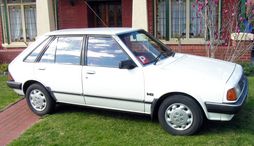
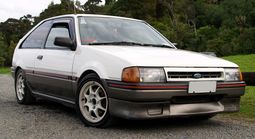
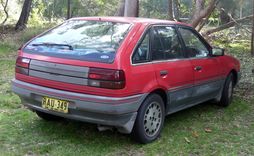



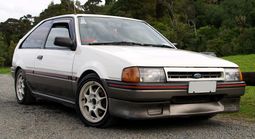
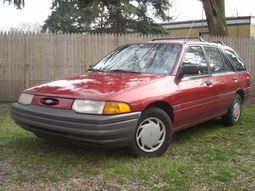
|